On this page:
What are pedestrian and bicycle paths?
Pedestrian and bicycle paths specifically provide for people on foot, bicycle or other mobility aid vehicles.
Paths may be located on local streets and major roads, in public spaces such as parks and reserves, or through semi-private spaces such as car parking lots, forecourts and arcades. Paths may be solely for pedestrian use, cyclist use, or shared paths for pedestrians and cyclists.
Pedestrian and bicycle routes should connect people directly with local destinations such as schools, shops, train stations and parks.
Why is it important?
Convenient, safe and comfortable pedestrian and bicycle paths are a valuable part of the movement network, and act as more than just thoroughfares. Footpaths are multi-use environments where people socialise, conduct business and observe the world around them as well as travel from one place to another on foot. Pedestrian and bicycle paths are also very important in enabling people to be physically active.
Pedestrian and bicycle paths are most inviting when they are direct, highly visible and well sign-posted, offer shade, seating and end-of journey facilities. The diverse needs of pedestrians and cyclists – children and young people, older people and those with a disability who may be using mobility aids – require inclusive design solutions.
2.3.1: ensure effective pedestrian and bicycle path connections to destinations
- Establish a continuous system of pedestrian paths connecting neighbourhoods, along all streets, continuing through public spaces, and to activity centres and public transport nodes.
- Include pedestrian paths on both sides of local streets and major roads.
- Where low levels of pedestrian and bicycle activity are expected, install shared paths for pedestrian and bicycle movement.
- Where high levels of pedestrian and cycle activity are predicted, install mode separated paths for pedestrian and bicycle movement.
Tip: a shared path is not appropriate where high volumes of pedestrian and bicycle traffic are expected.
- Where high levels of cyclists are predicted, locate kerb separated bicycle lanes on the kerbside of an on-street parking lane.
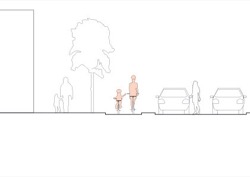
Tip: kerb separated bicycle lanes, such as the ‘Copenhagen’ style bicycle lanes, are safest where few crossovers to properties or cross-streets will intersect with the bicycle lane.
2.3.2: ensure pedestrian and bicycle paths are accessible and serviceable
- In designing a path, consider the functions the path will perform and the variety of people who may use it, including people with wheelchairs or prams.
- Set the path width to accommodate the anticipated or predicted levels of pedestrian and bicycle traffic.
- Allow for wider paths in areas with high levels of pedestrian or bicycle use or where growth in traffic is anticipated
- Allow for additional verge width to accommodate the space required for street furniture, facilities and infrastructure.

- Preserve a minimum height of at least 2.5m above the path that is clear from overhanging objects.
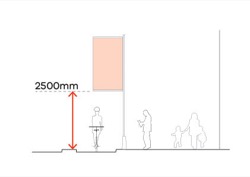
Tip: overhanging objects, trees, wires or signs can reduce the functional height of a path, and can be a hazard to pedestrians and cyclists. - On shared paths, allocate additional width for passing places and crossing places. Where bicycle paths curve, set an inside radius of at least 15m and preferably 30m.
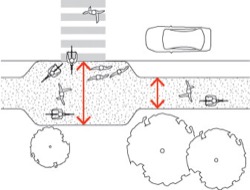
Tip: cyclists rely on forward motion to maintain balance. Slowing for sharp turns can unbalance inexperienced riders.
2.3.3: ensure pedestrian and bicycle paths maximise pedestrian and cyclist safety, amenity and security
- Lay out paths to allow pedestrians and cyclists clear sightlines for a distance of at least 15m ahead.
Tip: the clear distance provides a view line to potential threats or hazards, such as hiding spots or oncoming and crossing traffic.
- Where bordered by fences, set pedestrian or bicycle paths to be greater than 3m wide, and with a straight, or near to straight alignment.
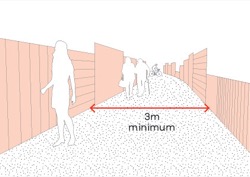
Tip: paths may need buffer space along sides where there are obstacles or hazards. - Where bordered by fences, arrange pedestrian or bicycle paths with opportunities for informal surveillance from adjacent properties.

Tip: paths bordered by fences or walls can feel unsafe, particularly in areas of low activity. Wider view lines and buildings overlooking pedestrian paths provide a sense of safety. - Minimise abrupt level changes along pedestrian and bicycle paths.
- Grade the surface of pedestrian and bicycle paths to shed water readily and locate drainage pits outside of the travel path.
- On busy or long distance paths, provide shade and shelter, way-finding signs and frequent seating.
- Provide formal seating at regular intervals along major walking routes to assist those who need to pause or rest.
Tip: seating placed at 100m intervals provides a comfortable stopping distance for less able walkers.
- Provide directed, low-glare lighting to pedestrian and bicycle paths along streets.
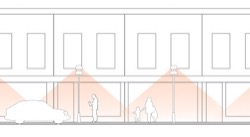
Tip: ensure street lighting illuminates pedestrian paths, not just the roadway.
2.3.4: ensure pedestrian and bicycle paths provide safety for pedestrians and cyclists on vehicle crossovers
Vehicle crossovers and entries to laneways can pose a risk to pedestrians and cyclists, both as trip hazards and vehicle collision hazards. For the design of vehicle exits from buildings refer to 5.4 Car parking structures, and for car parking lots 2.8 Car parking lots.
- Minimise the number of vehicle crossovers that intersect pedestrian and bicycle paths.
- Locate essential vehicle crossovers on straight street sections in areas of high visibility to approaching pedestrians and cyclists.
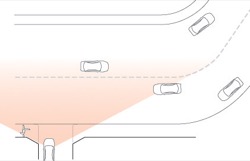
- Provide path treatments across vehicle crossovers to signal priority for pedestrians and cyclists.
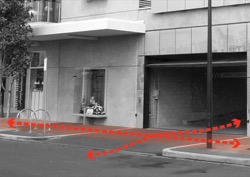
Tip: vehicle crossover surface treatments such as raised ‘bump-over’ paths, rumble strips and coloured path surfaces alert drivers to the presence of pedestrians or cyclists.
2.3.5: minimise hazards to pedestrians and cyclists from path edges
- Set pedestrian and bicycle paths back from the roadway or other obstructions.
- Set planting and trees well back from pedestrian and bicycle path edges.
Tip: where dense shrubbery and planting is close to a path, it can provide potential concealment opportunities for attackers. This is a particularly high risk on off-street pedestrian and bicycle paths.
- Design fences and barriers along bicycle lanes or paths to limit snagging handlebars or pedals, spearing injuries or collision.
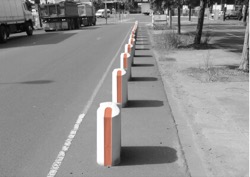
Tip: bollards, picket fences and log barriers pose a hazard to cyclists. Refer to 6.4 Barriers and fences. - Provide fences and barriers with reflective surfaces and light colours.
Tip: reflective treatments or light colours can enhance visibility of fences and barriers at night.
- Maintain clear sight-lines along paths and remove obstructions from areas adjacent to pedestrian and bicycle paths.
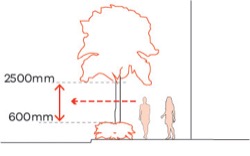
Tip: refer to VicRoads Supplement to the Austroads Guide to Road Design. - Implement a path maintenance program to preserve firm path edges, keep gravel paths compacted and remove loose material, trip hazards or debris from path surfaces.
2.3.6: ensure pedestrian and bicycle path management responds to changes in use patterns
- Monitor pedestrian and cyclist numbers and safety on paths to inform future improvements to pedestrian and bicycle paths.
- Consult with users when locating or modifying pedestrian and bicycle paths.
Tip: local communities have detailed knowledge of user behaviour, needs and preferences regarding path types and locations.
Page last updated: 09/06/23